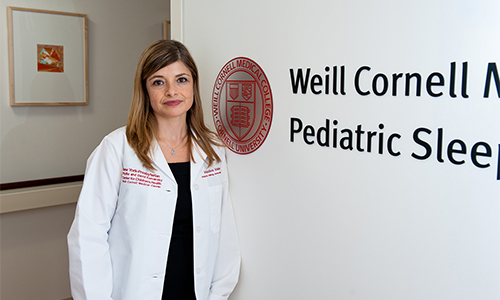A select population of neonates are known to be at an increased risk of sleep-related breathing disorders. In preterm infants, these can include recurrent apnea, bradycardia, and desaturation events often caused by central, obstructive, and mixed apneas. Immature respiratory control can lead to respiratory pauses, ineffective and/or obstructed inspiratory efforts, as well as feeding-related respiratory abnormalities. In term infants, apnea and intermittent hypoxemia can be a consequence of craniofacial anomalies or from neurologic disease associated with neuromuscular weakness.

Dr. Haviva Veler
Few studies have evaluated the use of polysomnography as a diagnostic tool in sleep-related breathing disorders for complex term and preterm infants. Haviva Veler, MD, Director of the Weill Cornell Pediatric Sleep and Breathing Disorders Center in the Division of Pediatric Pulmonology at NewYork-Presbyterian Komansky Children’s Hospital, collaborated with James Kim, MD, a neonatologist in the Division of Newborn Medicine, and colleagues in Biostatistics and Epidemiology and Pediatric Otolaryngology at Weill Cornell Medicine to conduct a retrospective cohort study of the value of polysomnography in the NICU. The study, which involved infants with recurrent desaturation episodes, suspected obstructive apnea, or both, aimed to:
- Determine the characteristics of term and preterm infants for whom polysomnography was used as a primary diagnostic tool, indication for the study, and incidence of abnormal results
- Identify interventions following polysomnography
- Assess the added value of airway and swallow evaluations
To the researchers’ knowledge, this is one of the first studies evaluating the diagnostic value of inpatient polysomnography in the NICU in infants with recurrent desaturation episodes, suspected obstructive apnea, or both.
Dr. Veler and the team reviewed the polysomnography data on 15 term and 16 preterm infants in the NewYork-Presbyterian Komansky Children’s Hospital NICU from January 2012 to April 2018. “The decision to perform a sleep study was determined by the attending neonatologist in consultation with a pulmonologist and otolaryngologist, and all testing was conducted in the NICU at the infant’s bedside,” says Dr. Veler.
Their findings, which were published in the August 2021 issue of the Journal of Clinical Sleep Medicine, revealed the indications for ordering an inpatient sleep study fell into three categories:
- 24 patients with persistent desaturations
- 15 patients with suspected obstructive apnea
- 2 patients with stridor
Primary comorbid conditions identified included respiratory, craniofacial, airway, and neurologic conditions. The apnea-hypopnea index was abnormal in 30 infants and of those 23 were severe and 7 were moderate. Apneic events were predominantly obstructive in 23 infants and central in 6. The apnea-hypopnea index improved in follow-up polysomnography in all infants but one. The findings resulted in interventions in 24 infants, in addition to otolaryngology evaluations and swallow studies.
To the researchers’ knowledge, this is one of the first studies evaluating the diagnostic value of inpatient polysomnography in the NICU in infants with recurrent desaturation episodes, suspected obstructive apnea, or both. Dr. Veler and her colleagues concluded: “In this patient population the apnea-hypopnea index was moderate to severe in most infants (86 percent), and most often obstructive in nature (74 percent). Targeted medical/surgical interventions resulted in clinical improvement in 22 infants (71 percent) and improvement on follow-up studies in 12 out of 13 infants. These findings indicate that polysomnography in the NICU, coupled with concomitant studies, are an important and new diagnostic tool in evaluating and guiding management of complex term and preterm infants with recurrent apnea.”



